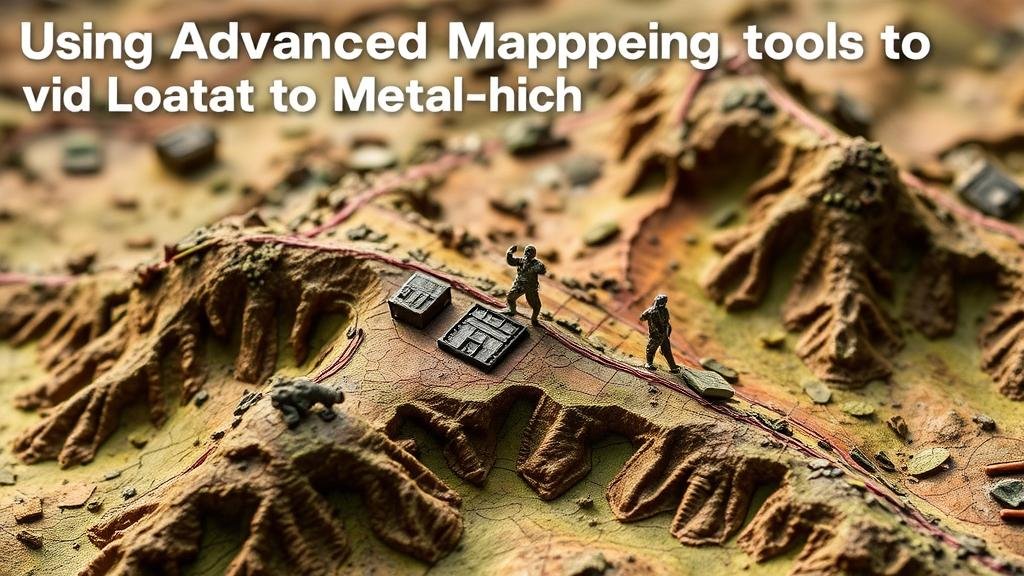Using Advanced Mapping Tools to Locate Metal-Rich Artifact Sites
Using Advanced Mapping Tools to Locate Metal-Rich Artifact Sites
In recent years, the application of advanced mapping tools has transformed the way archaeologists and researchers locate metal-rich artifact sites. These technologies not only enhance the precision of archaeological surveys but also significantly reduce the time and resources required in the field. This article delves into the principles and practical applications of these advanced tools, showcasing their importance in the identification and exploration of metal-rich artifacts.
The Role of Geographic Information Systems (GIS)
Geographic Information Systems, or GIS, play a pivotal role in modern archaeology. allow researchers to analyze spatial relationships and interpret geographical data effectively. By integrating different data types–including satellite images, topographic maps, and historical records–GIS provides a comprehensive view of potential excavation sites.
- Spatial Analysis: GIS enables the examination of spatial patterns related to human activity, helping to identify zones more likely to harbor metal artifacts. For example, a study in the Mediterranean region leveraged GIS to analyze ancient trade routes, leading to the discovery of previously unknown artifact sites.
- Site Prediction Models: Using machine learning algorithms, archaeologists can create predictive models that highlight areas rich in artifacts based on historical data and environmental variables. This method was notably used in the excavation of gold artifacts in the Andes, focusing on regions with specific geological features.
Integrating Remote Sensing Technologies
Remote sensing technologies, including LiDAR (Light Detection and Ranging) and ground-penetrating radar (GPR), have revolutionized the field by providing non-invasive means of site detection and analysis.
- LiDAR: This technology uses laser pulses to generate precise, three-dimensional information about the shape of the Earth and its surface characteristics. For example, a project in Cambodia uncovered extensive structures related to the Khmer Empire through the application of LiDAR, revealing a network of ancient settlements despite dense forest cover.
- Ground-Penetrating Radar: GPR is instrumental in detecting sub-surface anomalies that could indicate artifact deposits. In a notable archaeological endeavor in the American Southwest, GPR revealed buried metal tools and weapons, significantly propelling the excavation efforts of researchers.
Collaborative Data Sharing Platforms
As archaeological endeavors grow increasingly sophisticated, collaborative data-sharing platforms are becoming essential. e platforms facilitate the sharing of geospatial data among researchers globally, allowing for a more integrated approach to identifying metal-rich sites.
- Community Engagement: Platforms such as the Archaeological Mapping Platform (AMP) allow amateur archaeologists and community members to contribute their findings. The data collected has proven invaluable in identifying metal-rich areas that traditional methodologies might overlook.
- Historical Contextualization: Many mapping platforms incorporate historical data, enabling researchers to layer this information with current archaeological findings. This integration can significantly enhance the likelihood of locating rich artifact deposits. In Europe, such platforms have been used to re-evaluate historical battlefields, leading to exciting discoveries of weaponry and artifacts.
Case Studies in Metal Artifact Location
Several notable case studies highlight the efficacy of advanced mapping tools in locating metal-rich artifacts:
- The Maya Civilization: In the jungles of Belize, archaeologists utilized a combination of GIS and LiDAR to reveal previously uncharted urban centers of the ancient Maya civilization, uncovering extensive metalworking areas.
- The Roman Empire: In Romania, GIS methods combined with historical maps led to the discovery of numerous Roman military sites, rich in metal artifacts, enabling further studies into the empires metallurgical activities.
Challenges and Considerations
Despite the numerous advantages provided by these advanced mapping tools, some challenges must be addressed. Issues such as the accessibility of technology, the need for training in data interpretation, and the preservation of cultural heritage must be prioritized. Also, while advanced technologies can significantly aid in prospecting, they do not replace the need for on-the-ground expertise and contextual understanding.
- Technological Accessibility: Not all archaeological teams have equal access to expensive technologies like LiDAR or GPR, creating disparities in research capabilities.
- Training and Expertise: Effectively utilizing these advanced tools often requires specialized training, which may not be readily available to all researchers.
Conclusion: The Future of Archaeology
The intersection of advanced mapping tools and archaeology promises a future ripe with discoveries. By enhancing the accuracy and efficiency of site location, these technologies enable researchers to delve deeper into understanding past human activities. As tools like GIS, remote sensing, and data-sharing platforms continue to evolve, they will shape the way archaeological research is conducted, paving the way for significant advancements in locating metal-rich artifacts. This progressive trajectory will not only promote the recovery of historically significant items but will also foster a greater appreciation for global cultural heritage.
Takeaway Points
- Integrating GIS with historical data allows for better predictive modeling of metal-rich artifact sites.
- Remote sensing technologies, such as LiDAR and GPR, provide non-invasive methods to explore beneath the surface.
- Collaborative data-sharing platforms enhance research opportunities by allowing contributions from community members and various stakeholders.
- While advanced technologies greatly aid in archaeological exploration, expert fieldwork remains irreplaceable.



